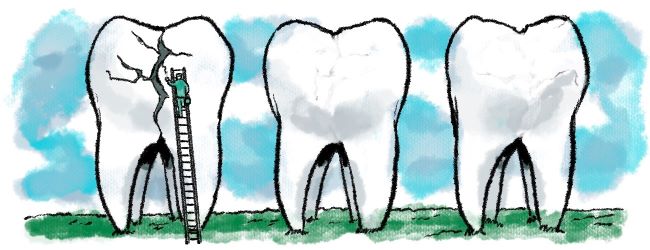Cracked, Not Condemned: Saving Treatable Teeth
 By Keith V. Krell, D.D.S.
By Keith V. Krell, D.D.S.
An October 31, 2024, a CBS News Health Watch report revealed dental practitioners who are needlessly extracting healthy, treatable teeth to justify implant replacements when many of the teeth could be saved. The report further alluded that this practice was simply to the financial benefit of the dental practitioner and was to the detriment of the patient.
In response to this report, the American Association of Endodontists (November 2, 2024) released a statement condemning the unwarranted extraction of teeth and replacement with implants.
Preservation of the natural tooth is less expensive, takes fewer appointments, and less time when compared to implants.[1]
We as an organization ought to continue to assume the mantle of “saving teeth”. Our “Worth Saving” campaign focuses on our ability to save teeth that were previously thought to be unsalvageable. Cracked teeth have frequently been condemned to extraction from the initial diagnosis. Prior to the pandemic endodontists reported seeing higher incidences of cracked teeth. With the pandemic, we definitely witnessed an increase in the incidences of cracked teeth, as seen in the paper by Nosrat.[2] We already new that early diagnosis of cracked teeth with a reversible pulpitis can allow for more conservative treatment, such as, ortho band placement and subsequently a crown without root canal treatment. Only one out of five or less may subsequently need root canal treatment in the future. [3, 4] Making sure your referring dental practitioners know this fact is critical in helping them make ethical decisions regarding their patients’ best care.
What do we know about cracked teeth that have developed irreversible pulpitis or pulp necrosis? For me, I rely on the four meta-analysis papers that are presently available. Olivieri, et al[5] concluded their analysis by saying root canal treatment in cracked posterior teeth can be considered a suitable treatment option. Leong, et al [6] concluded the overall tooth survival at 60 months was 84.1%. Chen et al.[7] found with a full-coverage. restoration in place, a much higher success rate (93.6%) compared to non-restored teeth. Zhang, et al[8] found the survival rate of the cracked teeth after root canal treatment with full-crown restorations (94.2–96.3 %) was higher than the overall survival rate (90.5–91.1 %). So in summary, these analyses all support cracked teeth receiving root canal treatment and a crown being preserved at 90-plus percent and above. These percentages may possibly improve from the suggestion by Dr. Matt Davis that after obturation, orifice barriers be placed to the deepest extent of the crack which he thinks may help strengthen the root as well as seal the canal from further bacterial penetration. His 4 year survival rates are 97 percent! [9] Taking these all together, cracked teeth have a decent prognosis. The one notable factor that has been shown to be a negative in the meta-analysis and in a study I did was deeper initial periodontal probings associated with the crack can have less success. [10]
To conclude, I have witnessed vast improvements in prognoses over my 40-plus years as an endodontist especially with respect to cracked teeth. Unfortunately, not all dental practitioners are aware of the strides in diagnosis and treatment of cracked teeth. I hope these few tidbits can be shared with colleagues to allow them to make the best treatment decisions for their patients and preserve more natural teeth.
- Vahdati, S.A., et al., A Retrospective Comparison of Outcome in Patients Who Received Both Nonsurgical Root Canal Treatment and Single-tooth Implants. J Endod, 2019. 45(2): p. 99-103.
- Nosrat, A., et al., Was the Coronavirus Disease 2019 Pandemic Associated with an Increased Rate of Cracked Teeth? J Endod, 2022. 48(10): p. 1241-1247.
- Krell, K.V. and E.M. Rivera, A six year evaluation of cracked teeth diagnosed with reversible pulpitis: treatment and prognosis. J Endod, 2007. 33(12): p. 1405-7.
- Abbott, P. and N. Leow, Predictable management of cracked teeth with reversible pulpitis. Aust Dent J, 2009. 54.
- Olivieri, J.G., et al., Outcome and Survival of Endodontically Treated Cracked Posterior Permanent Teeth: A Systematic Review and Meta-analysis. J Endod, 2020. 46(4): p. 455-463.
- Leong, D.J.X., et al., Outcomes of endodontically treated cracked teeth: a systematic review and meta-analysis. Clin Oral Investig, 2020. 24(1): p. 465-473.
- Chen, Y.T., et al., Factors Related to the Outcomes of Cracked Teeth after Endodontic Treatment. J Endod, 2021. 47(2): p. 215-220.
- Zhang, S., et al., The treatment outcomes of cracked teeth: A systematic review and meta-analysis. J Dent, 2024. 142: p. 104843.
- Davis, M.C. and S.S. Shariff, Success and Survival of Endodontically Treated Cracked Teeth with Radicular Extensions: A 2- to 4-year Prospective Cohort. J Endod, 2019. 45(7): p. 848-855.
- Krell, K.V. and D.J. Caplan, 12-month Success of Cracked Teeth Treated with Orthograde Root Canal Treatment. J Endod, 2018. 44(4): p. 543-548.




